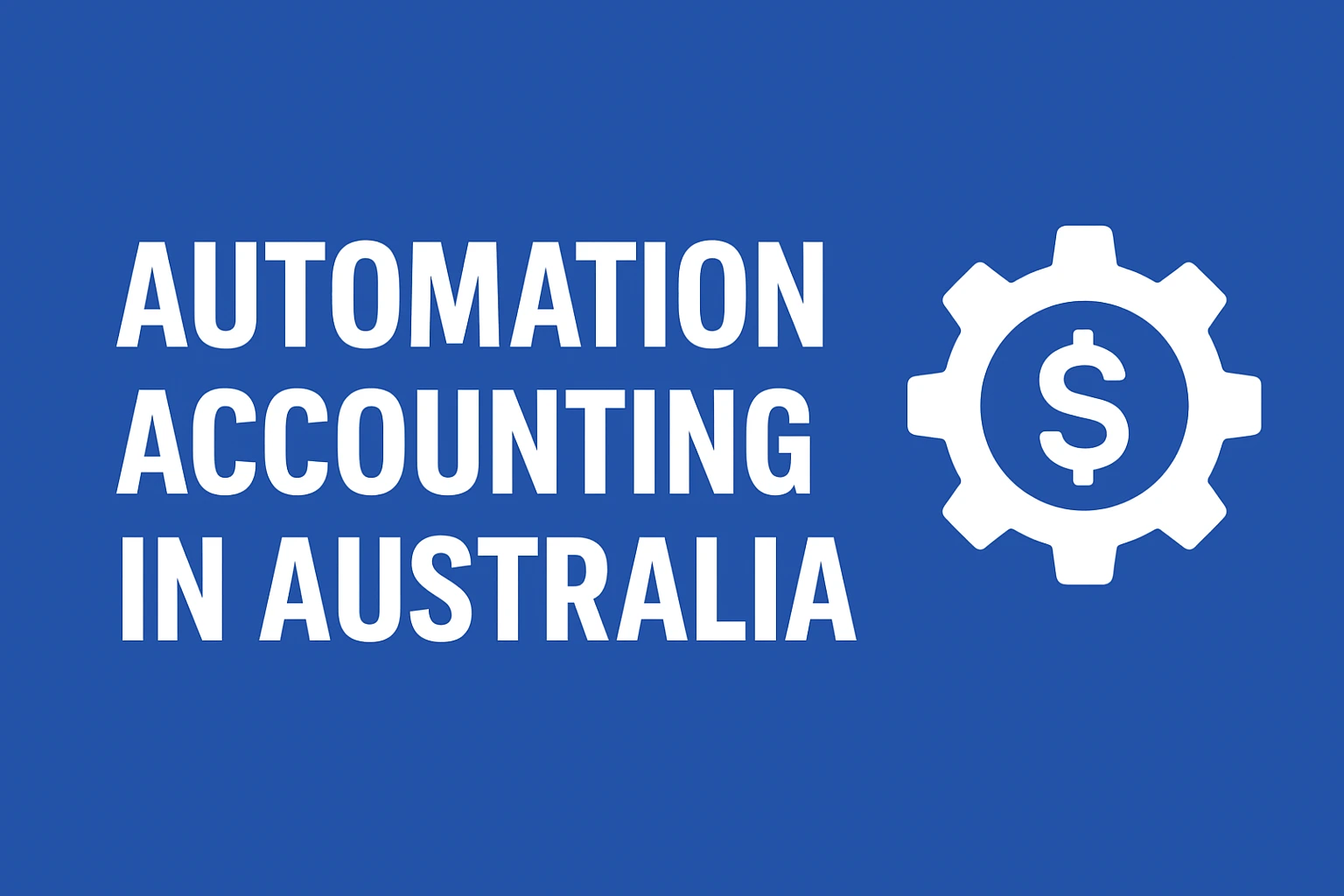
GET A FREE CONSULTATION TODAY!
Fill in the details, and our experts will contact you.

Submitting, please wait...
Join 1,500+ Businesses already Outsourcing Smarter with Aone Outsourcing Solutions. Save Time, Cut Costs & Stay 100% Compliant

The Australian business environment is changing, and automation is shaping how businesses conduct their financial affairs. With increased compliance requirements, staffing crises, and growing inefficiencies in manual bookkeeping, companies are now resorting to automated accounting to regain control, minimize errors, and build more scalable financial systems. This is not an exclusive move by big companies. Automation tools are now being used by small and mid-sized Australian businesses to simplify their daily accounting processes and make better decisions using real-time data.
Automated accounting can eliminate repetitive tasks that take up hours per week, allowing business owners and accountants to focus on strategy rather than manual entry. The following guide describes the definition of automation accounting, its operation, its advantages, the tools currently available in Australia, and the specific steps businesses can take to begin using it. Deeper and more understandable, with over 1,600 words, this is the tool that you will refer to in 2025.
Automation accounting is a system of technology-enabled accounting that includes activities performed with minimal human input. It automates manual data entry by providing digital workflows to capture, analyse, categorise, reconcile, and report financial information. It aims to minimize errors, improve process speed, and enable businesses to use their finances more effectively.
Accounting Automation does not kill accountants. Instead, it eliminates low-value work and gives professionals high-value work such as compliance oversight, financial analysis, advisory planning, and business strategy. Automation accounting is particularly beneficial for Australian businesses, as it helps comply with complex requirements such as GST, BAS, payroll laws, superannuation, and changes to ATO reporting.
When well applied, automation will establish an unbroken financial process in which an invoice transforms into a ledger into a report without waits and human bottlenecks. The outcome is a more precise, more consistent revenue procedure that performs as quickly as your company.
The Automation is achieved by combining OCR technology, cloud software, bank feeds, and workflow systems into a single interconnected process. The system reads documents, extracts information, and imports them into the accounting platform, eliminating the need for manual data entry. This starts with electronic data capture, where the invoices or receipts are scanned by software and converted into formatted financial information. After capture, the system classifies the transactions according to the setup rules.
Bank feeds keep the system up to date in real time, so when a matching invoice or payment is available, the system can reconcile it immediately. Approvals and workflow routing do not require human intervention, and the appropriate individual reviews transactions without sending emails or using paperwork. Missing invoices, late payments, and cash flow changes are notified via alerts, while dashboards provide real-time financial visibility.
The automation tools update tax categories, monitor GST, prepare BAS summaries, and ensure compliance with ATO requirements in the background. The entire ecosystem is designed to minimize manual intervention while maintaining the same level of accuracy across all financial processes.
Saving time is not the only benefit; as a business improves its financial control, efficiency, and decision-making accuracy.
The most apparent and immediate advantage of automation is time savings. Australian companies tend to dedicate hours per week to bookkeeping tasks such as data entry, reconciliations, and invoicing. This workload is significantly reduced by automation, enabling the system to capture and record financial information immediately. Automated companies close their accounts more quickly at the end of the month, prepare their BAS more quickly, and experience less pressure during accounting periods.
Compliance, forecasting, budgeting, and reporting heavily rely on accuracy. Manual accounting is very likely to result in miscalculations, duplications, and mis-coding of accounts. Automation helps eradicate these issues by eliminating the need to repeat tasks and supervise. The system captures financial information as it appears, ensuring that the reporting is always accurate, reliable, and auditable.
Automation provides financial information that is updated in real time, without delay, until the end of the month. Cash flow, outstanding invoices, payables, and profitability are all displayed in live dashboards as occurrences. This live image helps Australian business owners make slower, more informed decisions rather than relying on an obsolete spreadsheet or a delayed report. Real-time information is available that enhances more effective planning, budgeting, and forecasting.
One of the most challenging areas of accounting in Australia is compliance. Automation assists with GST, BAS reporting, Single Touch Payroll (STP) Phase 2, and superannuation. These attributes keep the businesses in check without pressure and panic. Automated systems update themselves whenever ATO regulations change, providing companies with confidence and reducing the risk of sanctions.
Automation also saves the accounting expenses by minimizing the need for manual labour and day-to-day work. It enables businesses to transact larger volumes of transactions without the need to hire more employees. For a growing company, automation provides a scalable financial infrastructure that keeps pace with business changes. This would lead to long-term cost consistency and make financial operations more predictable.
Traveling and working with cloud-based automation tools, teams, accountants, and business owners can be done from anywhere. This is a crucial aspect of doing business in Australia, where firms often operate across different states and regions. Automation simplifies intercompany transactions, consolidated reporting, and single financial control, which is why it is best used in multi-entity organisations. The remote collaboration process will be smooth without the need for physical paperwork.
A brief comparison is given below on the reasons businesses are getting upgraded:
|
Aspect |
Automation Accounting |
Traditional Accounting |
|
Speed |
Real-time processing |
Slow, batch-based work |
|
Accuracy |
High accuracy with fewer errors |
More prone to human error |
|
Cost |
Lower long-term cost |
Higher due to labour-intensive work |
|
Reporting |
Instant dashboards |
End-of-month statements |
|
Compliance |
Automated ATO updates |
Manual rule tracking |
|
Scalability |
Easy to scale |
Difficult without hiring |
Accountants are not being automated out of a job; they are being enhanced to be smarter, better, and faster.
Australia is characterised by one of the most developed cloud accounting technology markets in the world, and cloud accounting offers numerous automation tools for businesses to choose from. Xero is also among the leading options for small and medium enterprises because it is user-friendly and has robust automated features. MYOB provides powerful payroll and compliance management, which is why it appeals to companies accustomed to traditional accounting systems. QuickBooks Online is flexible in terms of automation and invoicing, and it offers excellent data capture.
Zoho Books offers robust pricing, including automation, whereas FreshBooks attracts freelancers and businesses with its simplified system. Tools such as Dext, AutoEntry, and Hubdoc are specifically designed to support automated data extraction via OCR. ApprovalMax automates approval workflows for companies seeking explicit financial control. These software solutions will result in a fully automated environment that will benefit both internal accounting staff and outsourced finance firms.
Businesses start by analyzing their existing workflows to identify repetitive manual tasks, such as invoice entry, reconciliation, payroll, and monthly reporting. Identifying time and effort waste can help develop a clear automation roadmap.
The choice of software will be determined by the size of the business, industry, number of transactions, and compliance requirements. A construction company may have more complex job costing needs, while an e-commerce business may need more payment integrations.
Integrations are associations between the accounting system and banks, point-of-sale systems, eCommerce platforms, payroll systems, and payment gateways. These integrations enable the automatic flow of financial data.
Some tasks that businesses can automate include accounts payable, accounts receivable, GST allocation, payroll processing, BAS preparation, expense management, and monthly reporting. The individual automated processes also help increase speed and consistency.
After acquiring automation, companies use the performance levels to maintain accuracy and make appropriate corrections where necessary. This is achieved through continuous optimisation that keeps the system aligned with evolving business requirements.
A large number of businesses would prefer outsourcing their automation systems to a consultant such as Aone Outsourcing to ensure that their systems are configured correctly and do not create mistakes that slow down operations during the first days of operation.
An e-commerce company based in Sydney was struggling to cope with the increasing volume of transactions. Manual reconciliation slowed operations, and BAS lodgements and supplier payments were often not timely. There was confusion in cash flow, and bookkeeping expenses were soaring.
Real-time financial dashboards became available to the business, and automated accounting reduced reconciliation time, increasing the number of business days saved. It reduced the prep work in creating BAS summaries and automated invoice calls, enhancing cash flows. The automation enabled the company to cut its accounting expenses by more than 40 percent and to achieve a more effective financial overview, indicating the transformative nature of accounting automation.
Some common pitfalls during the transition to automation include a complete transfer without periodic control.
Most companies choose software based solely on existing requirements and later realise it cannot support additional transactions, multiple entities, or enhanced reporting. A practical solution today will limit growth tomorrow. Selecting scalable software early can avoid costly migrations and operational disruptions down the line.
One frequent error is choosing accounting software without ensuring it integrates well with your CRM, eCommerce platform, payroll apps, or inventory management system. Lack of integrations will result in teams manually replicating data, thereby increasing errors and slowing down the financial process. Integrated software with a robust API and plug-and-play connectivity enables efficiency from the outset.
Although cost is essential, one might go directly to the cheapest tool, which will have fewer features, limited user access, or no automation features. This then translates into increased pay for businesses in the form of additional apps or manual inputs, which are relatively more expensive in the long run. It is prudent to strive for overall value, longevity, and ROI in the form of superior accuracy and quicker workflow.
But when software is too complex, it won't be used, even if it has a great set of features. A poor user interface leads to mistakes, wasted time, and frustration among accounting staff. Other factors to consider when assessing ease of use, dashboard clarity, and mobile usability are ensuring that a team actually gains the advantages of the software and does not face problems.
Most companies buy generic accounting software without even considering whether it fits their needs. Manufacturing companies must have job costing, construction companies must have project tracking, and e-commerce businesses must have real-time inventory synchronization. This leads to inaccuracies in financial data and an escalation of compliance risks when these essentials are absent.
Some businesses underestimate the time automation can save. They select the tools that involve manual reconciliations, manual invoice composition, or manual input of expenses. Not only does automation eliminate repetitive work and reduce errors, but it also frees up time to focus on analysis and strategy rather than data entry.
The future of financial management in Australia is being defined by automated accounting. Businesses can operate effectively with real-time information, with greater accuracy and faster processes. With high competition and the difficulty of complying with varying requirements, automation becomes a decisive advantage for any organisation, regardless of its size.
Aone Outsourcing provides companies with the opportunity to become automated under professional guidance, without any inconvenience in setting up systems or in receiving subsidies to support them. Australian businesses will be able to develop a more viable, scalable accounting system by 2025 and beyond with the tools and a trusted partner.
Automation is not an accountant replacement. It eliminates routine work, thus allowing accountants to focus on more analytical, advisory, compliance, and strategic planning work.
Small businesses will benefit from expedited processing, reduced errors, real-time financial information, and lower bookkeeping costs. Automation assists them to be used more effectively, and they do not require massive workforces.
Automation is programmed, and AI is relying on pattern recognition and prediction. Automation does perform work, and AI helps with forecasting, anomaly detection, and generating insights.
The automation systems employed nowadays are encrypted, multi-factor-authenticated, stored in secure cloud data centers, and updated regularly. They comply with high Australian data protection standards.
Some jobs can be automated without using cloud platforms; however, full automation requires cloud platforms with integrations, real-time syncing, and automated compliance features.
At Aone Outsourcing Solutions, we believe smart businesses don’t just manage their accounting; they streamline their accounting process. With years of experience supporting accounting firms and businesses across the UK, USA, Canada, Australia, and Ireland, our team knows how to turn everyday financial processes into strategic advantages.
From bookkeeping and payroll to tax preparation, accounts payable, and compliance, we’ve helped firms simplify their accounting workflows, cut operational costs, and maintain complete accuracy at every step.
Because at Aone, your accounting success is the goal we care about most.
Aone Outsourcing Solutions
Content on this website is shared for general awareness and educational purposes only. It should not be taken as financial, accounting, taxation, or legal advice. At Aone Outsourcing Solutions, we do our best to keep all information relevant and accurate; however, we can’t promise that every detail is up to date or fits every business situation. Because regulations and compliance requirements can change, we encourage you to seek guidance from an expert professional before acting on any information on this site. Aone Outsourcing Solutions will not be responsible for any decisions made or losses incurred based on the material published on this website. For advice specific to your business needs, please get in touch with our team .
Special characters are not allowed.